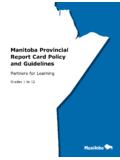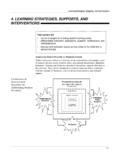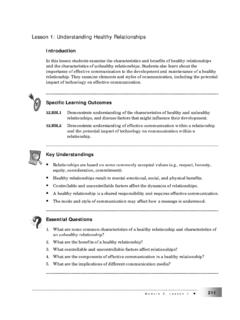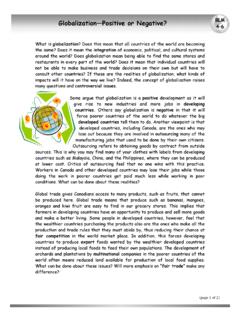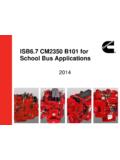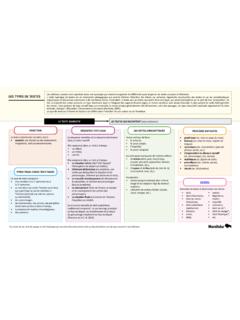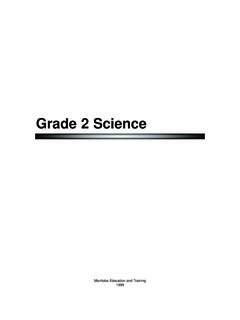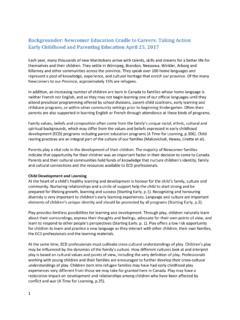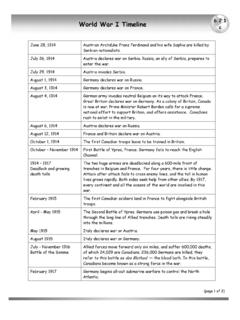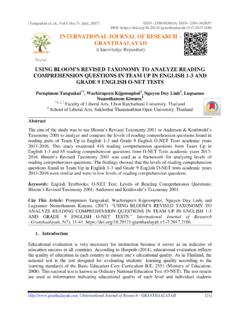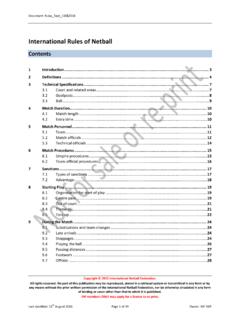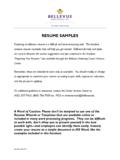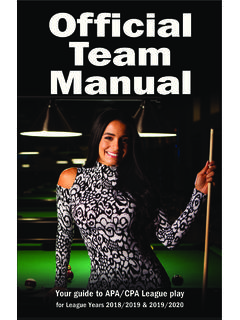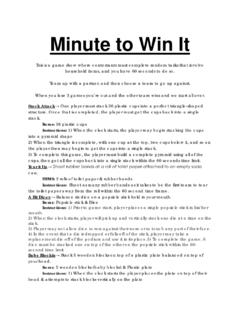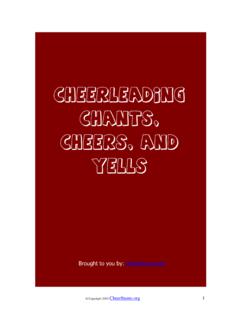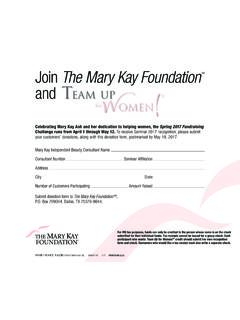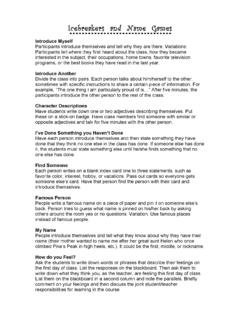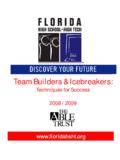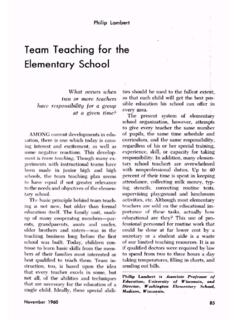Transcription of Lesson 2: Team-Building and Communication Skills
1 _____ Module D, Lesson 2 187 Lesson 2: Team-Building and Communication Skills Introduction In Lesson 1 of Module D, students examined the characteristics of effective teams and the development stages that teams go through from Forming to Adjourning, as identified by Bruce W. Tuckman. In order for a team to accomplish its goal(s), it is important for the team members to understand that they may play a number of different roles within a given team . Furthermore, individuals within a team need to appreciate the roles assumed by or assigned to the other team members. To gain this understanding and appreciation of team roles, a team needs the opportunity (at the appropriate time in its development) to build a sense of being a team . These Team-Building activities involve cooperation, teamwork, and Communication . This Lesson focuses on the elements of teamwork and the Skills required to work and to communicate effectively within teams. Being able to function effectively as a team member is a necessary skill for success in the workplace, in sports, in family units, and so on.
2 _____ Specific Learning Outcome Explore and identify the various roles and Skills of team members in building effective teams. _____ Key Understandings team members play varying roles that contribute to or detract from team effectiveness. Communication is a vital element of effective teams. _____ Essential Questions 1. What roles do people play within teams that lead to success? 2. How do Communication Skills contribute to team effectiveness? _____ _____ 188 Grade 12 Active Healthy Lifestyles Suggestion for Instruction / Assessment All Hands On: An Activating Activity This activating activity is intended to help teams develop effective Communication and problem-solving Skills . Directions/Description Form teams of about eight students. Supply each team with one bandana, one marble, and one plastic cup that has some kind of lip on the bottom. The team members surround the bandana and hold onto it along the edges with both hands, creating a tabletop effect.
3 The team then places the cup upside down in the middle of the bandana and places/balances the marble on top of the cup. The task of the team is to transport the bandana-cup-marble apparatus from point A to point B, as described by the teacher. Possible Variations Smaller teams may be easier to work with. As the teams move from point A to point B, they encounter obstacles to navigate around, over, and so on. Possible Debriefing Questions 1. What did you enjoy about this team activity? 2. What was your team s greatest challenge? 3. How does the bandana symbolize how a team works together? _____ Background Information team Roles In Lesson 1 of Module D, students examined which characteristics were evident in successful teams and which characteristics were lacking or not evident in unsuccessful teams. A team is made up of all sorts of people. How these people interact and relate to one another is a key factor in determining how successful the team will be at achieving its goals.
4 Some people are primarily concerned about getting the work done, others are helpful and supportive to team members, and still others can cause dissension or conflict within the team . _____ Module D, Lesson 2 189 High-performing teams don t just happen. They develop because the team members pay attention to the tasks and to team interactions. High-performing teams get the job done and enjoy the process along the way. The team members are energized and hard-working, and manage themselves in their respective roles. The team s end product is characterized by excellence in quality and quantity. Functional Roles of team Members Kenneth D. Benne and Paul Sheats, two theorists on group behaviour, wrote an influential article titled Functional Roles of Group Members in 1948. In this article, the authors defined various roles based on behaviours that can be played by one or more people within a group or team . Benne and Sheats defined three categories of roles: task roles, personal/social roles, and dysfunctional or individualistic roles.
5 In this Lesson , the following three categories are used as the framework for understanding and strengthening a given team : Task roles/actions move a team toward accomplishing their objectives. These actions include setting goals, identifying tasks, gathering facts, providing information, clarifying and summarizing ideas, and building consensus. The possible roles within this category are those that may be needed to advance a team from the Forming to the Performing stage of team development. Interactive roles/actions are directed at the operation of a team or how the team is working together. These actions include encouraging participation, expressing feelings, reconciling disagreements, keeping Communication open, setting and applying standards for group performance, and building on each other s ideas. It is through these actions that teams function positively and effectively. Self-oriented roles/actions put the needs of the individual ahead of the needs of the team .
6 They include dominating the discussion, interrupting, wasting time, not listening, withdrawing from the conversation, and holding side conversations. A team that has individuals demonstrating these behaviours is in jeopardy of not realizing its goals/objectives. Well-established teams will be able to manage these behaviours. Newly formed teams may require leader intervention. Knowing the behaviours that can move a team forward or hinder its progress can be helpful to all team members. REFERENCE For additional information, refer to the following article: Benne, Kenneth D., and Paul Sheats. Functional Roles of Group Members. Journal of Social Issues (Spring 1948): 41 49. _____ _____ 190 Grade 12 Active Healthy Lifestyles Suggestion for Instruction / Assessment Predicting team Roles Have students participate in a learning activity to predict various team roles. Directions/Description On three separate pieces of flipchart paper, write one of the following three categories: Task Roles Interactive Roles Self-oriented Roles Divide the class into three groups.
7 Using the Carousel Brainstorming strategy (see Appendix E), assign each group to one of the three pieces of flipchart paper. Give each group a certain amount of time to identify possible roles within the identified category. After the initial time has expired, allow each group to move to the next category and add other roles that they think fit within the category description. Once groups have completed all three categories, review the results as a class. Check whether there is agreement and/or whether any clarification is needed. Following the review, have students share their own team experiences related to the identified roles. For example, do they recognize these terms by name in the teams they are currently part of? _____ Suggestion for Instruction / Assessment building a Structure as a team This learning activity provides students with an opportunity to work on team building , develop Communication Skills , and gain an understanding of the roles within a team and how they present themselves.
8 Materials Required Each team requires a handful of uncooked spaghetti 30 jujubes (jelly-like candies) The teacher requires a measuring tape _____ Module D, Lesson 2 191 Directions/Description Divide the class into groups of five to seven students. Each team will need one person to act as the process observer. Ask each team to design and build the tallest free-standing structure possible in the time allotted, using the materials supplied. Before the team begins construction, allow each team five to ten minutes to discuss their design and plan. The teams could give their structure a name. After the planning time has elapsed, teams may begin construction. The process observer in each team watches and records (using RM 1 PS) how the team interacts and communicates during the building process, what team roles emerge, and who takes on these roles. (Students may need to refer to the roles identified in the Predicting team Roles learning activity.)
9 Periodically, announce how much time has elapsed and how much time is remaining. Once the allotted time has elapsed, have teams step away from their structures. Measure each structure to determine which is the tallest. Refer to the roles identified in Predicting team Roles (previous learning activity) and to RM 1 PS: Process Observation Report Form. Possible Debriefing Questions Questions such as the following could be put on an overhead or on a chalkboard for each team to answer, with the process observer recording team responses on flipchart paper for discussion. 1. What did you learn through this building activity about the functioning of a team ? 2. Did team members have specific roles? If so, how were these roles determined? 3. In general terms, how was Communication used ( , positive, negative, neutral)? Give examples of words, phrases, or expressions used and/or heard. 4. Given the team experience, what were your team s strengths and possible areas for improvement?
10 How could you contribute better to your team s effectiveness? After the teams have answered the debriefing questions, have the process observers share their observations of their respective teams with the class. Discuss the responses as a class. _____ NOTE TO TEACHER Remind process observers not to use students names when recording or reporting observations. _____ 192 Grade 12 Active Healthy Lifestyles Background Information Individual Communication Skills Now that students have examined and experienced the characteristics of effective teams, it is important to determine the individual Communication Skills required to establish team relationships that support these characteristics. The individual Communication Skills include the following: Listening: Listening actively involves looking directly at the person who is speaking (taking into consideration cultural appropriateness), focusing intently on what is being said, and nodding to indicate attentiveness, understanding, or approval.
